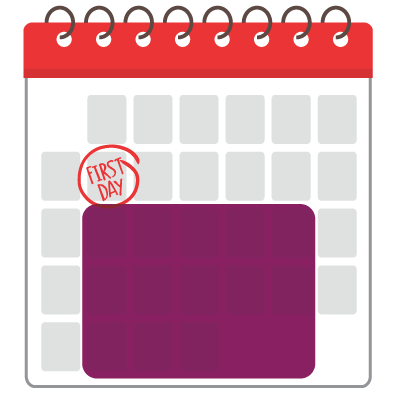Don’t underestimate the importance of onboarding. An effective onboarding process is critical to the immediate success of new employees as well as the long-term success of the entire team. A well-thought-out onboarding plan and following onboarding best practices will give new employees a great first impression and all the tools they need to succeed during their first three months in the role (and beyond). It’s also a surefire way to retain top talent, especially since companies always face the risk of losing high-potential employees.
The Importance of Onboarding: Three Supporting Roles to Set New Hires Up for Success
There are three supporting roles that can help a new hire get acclimated to a new company or position. Those roles include their leader, a buddy, and a mentor.
The leader.
The new employee’s leader is their primary source of support. Leaders should be prepared to guide new employees through the entire onboarding process, help them to acclimate to the role and organization, provide clear expectations and feedback, and ensure their experience is welcoming and inclusive. In addition to discussing performance expectations, leaders should begin discussing short- and long-term development goals with their new team members right away and support them in creating a plan to achieve those goals.
A buddy.
An onboarding buddy is a person who can meet with the new hire throughout their first few weeks or months to provide guidance and help them begin to build their internal network. Selecting a buddy who is a peer of the new hire and with lower tenure (one to three years) is ideal as they are more likely to relate to the new employee and empathize with the experience of being a new hire. A buddy should have strong interpersonal skills, be eager to help others, and exemplify the organization’s values. Often, a new hire’s “buddy” becomes a close colleague and supportive friend, both inside and outside of the organization. So, give extra thought in assigning a new team member’s onboarding buddy, since they tend to ease any nerves associated with transitioning into a new role.
A mentor.
A buddy can and often does play the role of a peer mentor. But it can be invaluable to also connect new hires with a more formal mentor who can build rapport, provide long-term advice, and share insight into what it takes to succeed in the organization and the industry. Consider the background, experience, goals, personality, and readiness of new hires and potential mentors to ensure a good fit. While some new employees are ready for a mentor early on, others may be overwhelmed by starting a relationship with a mentor too soon. So be sure to consider the appropriate timing of a new mentoring relationship.
Onboarding Best Practices: Step by Step
The onboarding experience begins well before a new hire’s first day and, on average, lasts through the first three months. The following are key steps and best practices for leaders to ensure their new employees feel welcomed, connected, and set up for success.


Before Day One
In the weeks leading up to the new employee’s start date, create a robust onboarding plan tailored to the new hire’s role, skills, and experience. Include clear learning goals for the first 30, 60, and 90 days on the job as well as a plan to help connect the new hire to their peers and leaders in the organization. Add them to appropriate recurring meetings and schedule weekly one-on-one meetings to stay closely connected to the new employee in their first few months. Frequent communication is the best way to keep a pulse on how things are going and where they could use some extra help.
Build excitement! Share an announcement with the current team and others in the organization to let them know that a new employee will be starting soon and encourage them to reach out with a warm welcome. Schedule a call with the new employee the week before their start date to let them know how excited you are to have them join the team. You can also use this time to review instructions and expectations for the first day, including their start time, the schedule for the first week, the company’s dress code, and directions to the office and/or parking if applicable. Send an email as a follow-up so they have this information in writing.
Plan for their start date by reviewing the technology, equipment, and supplies they need to get started on day one. This includes making technological arrangements for remote work, setting up equipment in a physical workspace, granting access to software systems and accounts, and anything else necessary to make sure the new employee has a seamless experience on their first day. Don’t forget to have any promotional materials, company swag, welcome sign, or card set up on the employee’s desk or sent to their home office ahead of time!

Day One
Focus on welcoming your new team member and making sure they know how to navigate their new workspace (either virtual or onsite). Encourage them to engage in the organization beginning on day one. Their first day should include a chance to meet their buddy and have a formal meeting with their manager to review their onboarding plan and discuss the role and responsibilities in greater detail.
Orient the new employee to the organization through a formal or informal new hire orientation experience and be sure they know how to find important information and resources, such as benefits information, the code of conduct, calendars, and other policies. If possible, take the new employee out to lunch to give them a chance to get to know you, their buddy, and/or other members of the team.

Week One
Spend time getting to know the new employee, including their work style, communication preferences, dislikes, and motivations. Help them get to know you and your leadership style and set expectations for how the two of you will work together. Be sure that learning objectives are clearly defined, and that the new employee knows what is expected of them in their first few months. Align on how progress will be measured.
In addition to learning how to perform their job, new employees should learn where they sit in the company relative to other job functions and how their role aligns with the overall business strategy.
When a new employee gains an understanding of how the organization works early on, they can more easily start building networks early, too. And building strong networks will allow them to see who they need to work with to get things done.
The first week of employment is also a great time to engage new hires in social activities. But keep the employee’s personality in mind when planning.
For instance, more introverted people may be more easily overwhelmed by interactions with large groups and may thrive in smaller or one-on-one meetings. However, more extroverted individuals may benefit from or prefer a larger social gathering. Regardless of personality type, it’s imperative that all new team members feel included during their first week on the job. A high-quality DEI program can help to ensure that new hires have the opportunity of a strong start in the organization.

Week Two and Beyond
Week two and beyond should focus on setting the employee up for success in their job moving forward. Leverage the onboarding plan you created to guide them through their learning; however, remember to stay flexible and allow them to learn at their own pace. Provide opportunities to practice applying new skills in a safe space (for example, skill practice or role play), and share ongoing positive and developmental feedback. Help them to see mistakes (they’re inevitable!) as opportunities for learning and growth.
While the first several weeks on the job are typically consumed with taking in information, providing opportunities for the new employee to contribute and add value right away can be a great way to build confidence and boost engagement. Consider asking them to do research and share recommendations for a team project or to share their knowledge, previous experiences, and fresh perspective as part of an organizational or team initiative. Recognize the value they are adding to the team, even as they are still getting up to speed in their new role.
More Onboarding Best Practices for Year One
It is common for new hires to feel isolated, especially if they are working in a remote or hybrid environment. Check in frequently with new employees during the first year to understand how well they are adjusting. Establishing these check-ins from the get-go allows leaders to address any concerns the new team member has and to provide ongoing support. Contact should be frequent at first and can be adjusted as the new employee gets acclimated to their role.
New employees can also provide meaningful feedback on company initiatives and policies. They often bring a fresh perspective on the business and company culture and may be more likely to bring up potential culture issues because they haven’t established political bonds that often prevent this type of openness. Seek their feedback on the onboarding process and use that feedback to continuously improve.
Don’t forget to celebrate successes and milestones throughout their first year! New employees often face a steep learning curve, which can be both challenging and frustrating. Recognizing their hard work and offering encouragement can make a big impact.
The Importance of Onboarding When Employees Move Around
Remember that effective onboarding and adjusting to a new role can happen many times as employees are promoted or switch roles. Provide a revised onboarding program to employees who change roles. It’s never good to assume that a current employee knows everything they need for a new position just because they already work for the company.
The Importance of Onboarding to Employee Retention
A quality onboarding experience is critical for both brand new employees and employees switching roles. Without a good onboarding plan, it’ll be hard for your new employees to be successful quickly.
But really, without a good onboarding plan, new employees will have a hard time being successful at all. And when people aren’t engaged in their work, they’re more likely to leave. The importance of onboarding your team members well is critical to retaining them.
Develop your leaders to drive employee engagement. Learn how DDI can help you boost engagement and retention.
Lauren Resk is a learning and development consultant on DDI’s Global People Services Team. When she’s not supporting the growth and development of DDI’s leaders and associates, you’re likely to find her exploring a new creative endeavor or spending time outside with her two dogs Maui and Bennett.
Topics covered in this blog

